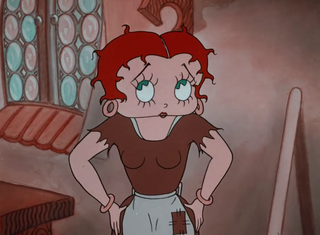Related Research Articles

Betty Boop is an animated cartoon character designed by Grim Natwick at the request of Max Fleischer. She originally appeared in the Talkartoon and Betty Boop film series, which were produced by Fleischer Studios and released by Paramount Pictures. She was featured in 90 theatrical cartoons between 1930 and 1939. She has also been featured in comic strips and mass merchandising.

Talkartoons is a series of 42 animated cartoons produced by Fleischer Studios and distributed by Paramount Pictures from 1929 to 1932.
Myron Waldman was an American animator, best known for his work at Fleischer Studios.

Mae Questel was an American actress. She was best known for providing the voices for the animated characters Betty Boop and Olive Oyl.

Myron "Grim" Natwick was an American artist, animator, and film director. Natwick is best known for drawing the Fleischer Studios' most popular character, Betty Boop.

Helen Kane was an American singer and actress. Her signature song was "I Wanna Be Loved by You" (1928), featured in the 1928 stage musical Good Boy. The song was written for Good Boy by the songwriting team Kalmar and Ruby. Kane's voice and appearance were thought to be a source for Fleischer Studios animators when creating Betty Boop. Kane attempted to sue the studio for claims of stealing her signature "boop-oop-a-doop" style, but the judge decided that the proof of this was insufficient, thus dismissing the case. Fleischer Studios later admitted that Kane had been the inspiration for Betty Boop.
Fanny Zilch is an animated cartoon character, part of the Terrytoons series. She made her debut in 1933. Her cartoons were musical spoofs of melodrama serials like The Perils of Pauline, in which blonde sweetheart Fanny -- "the Banker's Daughter" -- was pursued by the villainous Oil Can Harry, and protected by the heroic J. Leffingwell Strongheart.
Stopping the Show is a 1932 Fleischer Studios animated short, directed by Dave Fleischer. While it is not the first appearance of Betty Boop, it is the first short to be credited as "A Betty Boop Cartoon".
She Wronged Him Right is a 1934 Fleischer Studios animated short film starring Betty Boop. It marks the first appearance of Betty's semi-regular boyfriend, Fearless Fred.
Betty Boop's Rise to Fame is a 1934 Fleischer Studios animated short film, starring Betty Boop.
Betty Boop for President is a 1932 Fleischer Studios animated short film starring Betty Boop. It was released by Paramount Pictures on November 4, 1932, four days before that year's presidential election day.

Poor Cinderella is a 1934 Fleischer Studios-animated short film featuring Betty Boop. Poor Cinderella was Fleischer Studios' first color film, and the only appearance of Betty Boop in color during the Fleischer era. It was the first Paramount Pictures animated short in color.
Betty Boop and Grampy is a 1935 Fleischer Studios animated short film starring Betty Boop. The short features Grampy in his first appearance.
A Language All My Own is a 1935 Fleischer Studios animated short film starring Betty Boop.
Betty Boop with Henry, the Funniest Living American is a 1935 Fleischer Studios animated short film starring Betty Boop, and featuring Carl Anderson's Henry. The short was also released as Betty Boop with Henry.
Betty Boop's Trial is a 1934 Fleischer Studios animated short film, starring Betty Boop.
Betty Boop's Life Guard is a 1934 Fleischer Studios animated short film starring Betty Boop.
Betty Boop's Prize Show is a 1934 Fleischer Studios animated short film starring Betty Boop.
Honest Love and True is a 1938 Fleischer Studios animated short film starring Betty Boop and her stage partner who's similar to a Snidely Whiplash character, and also another character who's playing as what seems to be a park official.

Lillian Friedman Astor was an American animator who was one of the first female animators in the country. She worked for Fleischer Brothers' studio, inking and eventually animating various Betty Boop cartoons, as well as one Popeye, some Color Classics, and several Hunky and Spunky cartoons, although she received screen credit on only six of the forty-two cartoons she animated in her lifetime.
References
- 1 2 Beck, Jerry (May 29, 2013). "Fleischer's Animated News #6". Cartoon Research. Retrieved December 19, 2024.
- ↑ Lenburg, Jeff (1999). The Encyclopedia of Animated Cartoons . Checkmark Books. pp. 54-56. ISBN 0-8160-3831-7 . Retrieved June 6, 2020.
- ↑ Pointer, Ray (2017). The Art and Inventions of Max Fleischer: American Animation Pioneer. McFarland & Co. p. 106. ISBN 978-1476663678 . Retrieved February 9, 2020.